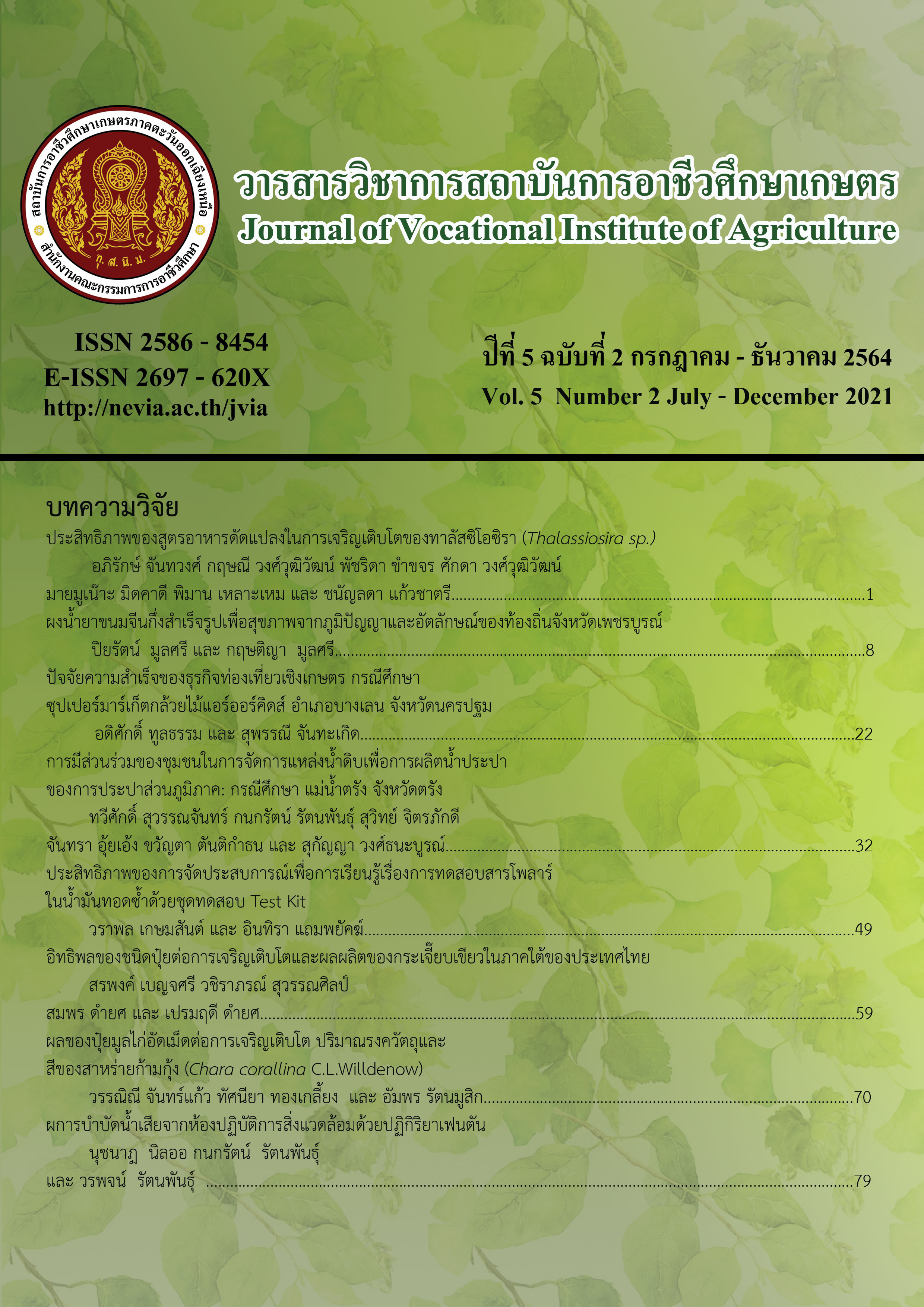Dried Curry Sauce Powder of Rice-Noodles for Health from Local Wisdom and Identity of Phetchabun Province
Main Article Content
Abstract
This work has studied the preparation of dried curry sauce powder of rice-noodles products for health from local wisdom and identity in Phetchabun Province. From the study, it found that the basic formulation of the dried curry sauce was prepared from a mixture of fish meat 53%, red onion 8%, garlic 8%, kaempferia 8%, lemon grass 8%, galangal 7%, chilli 4%, kaffir lime 2%, and shrimp paste 2%. It was dried at the optimum conditions of 70 0C for 3 hours. The pulverized dried powder was 28.7% by weight of the total weight of the recipe. The preparation cost is approximately 0.32 baht per gram. It contains 50.8-54.4% carbohydrate content, 10.0-13.4% protein content, 20.0-24.2% fat content, 2.6-6.8% fiber content, ash content of 4.3-4.9%, and moisture content of 3.3-4.3%, respectively. Consumers are accepting and liking at a high level. and quality according to community product standards (498/2547) as specified by local foods containing medicinal plants as a food that is good for the health of consumers and can extend the storage period from developing into dried curry sauce powder of rice-noodles products.
Article Details

This work is licensed under a Creative Commons Attribution-NonCommercial-NoDerivatives 4.0 International License.
The content and information in articles published in the Journal of Vocational Education in Agriculture are the opinions and responsibility of the article's author. The journal editors do not need to agree or share any responsibility.
Articles, information, content, etc. that are published in the Journal of Vocational Education in Agriculture are copyrighted by the Journal of Vocational Education in Agriculture. If any person or organization wishes to publish all or any part of it or to do anything. Only prior written permission from the Journal of Vocational Education in Agriculture is required.
References
สำนักโฆษก สำนักเลขาธิการนายกรัฐมนตรี ทำเนียบรัฐบาล. (2560). Thailand 4.0 ขับเคลื่อนอนาคตสู่ความมั่นคง มั่งคั่ง ยั่งยืน. วารสารไทยคู่ฟ้า, 33, 1-44.
ศิริลักษณ์ สินธวาลัย. (2529). การพัฒนาผลิตภัณฑ์ทางโภชนาการ. กรุงเทพฯ: ภาควิชาพัฒนาผลิตภัณฑ์ มหาวิทยาลัยเกษตรศาสตร์.
สุมณฑา วัฒนสินธุ์ และคณะ. (2544). การพัฒนาเทคโนโลยีการเก็บรักษาเครื่องแกงเผ็ดและน้ำปรุงรสผัดไทย. วารสารกรมวิทยาศาสตร์การแพทย์, 43(4), 308-322.
ชมพูนุท สีห์โสภณ. (2558). การพัฒนาผลิตภัณฑ์ขนมจีนน้ำยากึ่งสำเร็จรูป (รายงานผลการวิจัย). กรุงเทพฯ: สถาบันเทคโนโลยีพระจอมเกล้าเจ้าคุณทหารลาดกระบัง.
สมบัติ ขอทวีวัฒนา. (2529). กรรมวิธีการอบแห้งอาหาร. กรุงเทพฯ: ภาควิชาพัฒนาผลิตภัณฑ์ คณะอุตสาหกรรมเกษตร มหาวิทยาลัยเกษตรศาสตร์.
ธงชัย สุวรรณสิชณน์. (2555). เทคนิคการประเมินคุณภาพทางประสาทสัมผัสและการวิเคราะห์. กรุงเทพฯ: ภาควิชาพัฒนาผลิตภัณฑ์ คณะอุตสาหกรรมเกษตร มหาวิทยาลัยเกษตรศาสตร์.
เพ็ญขวัญ ชมปรีดา. (2556). การประเมินคุณภาพทางประสาทสัมผัสและการยอมรับผู้บริโภค. กรุงเทพฯ: บริษัท
วิสต้าอินเตอร์ปรินท์ จำกัด.
ไพโรจน์ วิริยจารี. (2545). การประเมินทางประสาทสัมผัส (Sensory Evaluation). เชียงใหม่: คณะอุตสาหกรรมเกษตร มหาวิทยาลัยเชียงใหม่.
กฤชฎา ศึกษากิจ และ กิติมา สัจจาพิทักษ์. (2544). การศึกษาเส้นขนมจีนกึ่งสำเร็จรูป. (ปัญหาพิเศษ, สถาบันเทคโนโลยีพระจอมเกล้าเจ้าคุณทหารลาดกระบัง).
จารุพรรณ ใบนาค รัตนาพร วงค์ภักดี และอโนชา สุขสมบูรณ์. (2558). การพัฒนาผลิตภัณฑ์ขนมจีนอบแห้งผสมข้าวไรซ์เบอรี่. วารสารวิทยาศาตร์เกษตร, 46(3), 361-364.
Association of Official Analytical Chemistry (AOAC). (2000). Official Methods of Analysis of AOAC International. 17th Ed. Gaithersburge, MD: AOAC International.
U.S. Food & Drug Administration. (2020). Bacteriology Analytical Manual (BAM). From https://www.fda.gov/food/laboratory-methods-food/bacteriological-analytical-manual-bam.
Frazier, W.C. (1988). Food Micrology. 4th ed. New York: Mc Graw-Hill Book Company.
Association of Official Analytical Chemistry (AOAC). (1984). Official Methods of Analysis of AOAC International. 14th Ed. Arlington, VA: AOAC International.
สำนักงานมาตรฐานผลิตภัณฑ์อุตสาหกรรม กระทรวงอุตสาหกรรม. (2547). มาตรฐานผลิตภัณฑ์ชุมชนน้ำยาขนมจีนกึ่งสำเร็จรูป (มผช.498/2547). เข้าถึงได้จาก http://tcps.tisi.go.th/pub/tcps 498_47.pdf.

